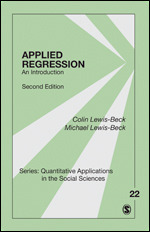Applied Regression
An Introduction
- Colin Lewis-Beck - Iowa State University, USA
- Michael Lewis-Beck - The University of Iowa, USA
Available with Perusall—an eBook that makes it easier to prepare for class
Perusall is an award-winning eBook platform featuring social annotation tools that allow students and instructors to collaboratively mark up and discuss their SAGE textbook. Backed by research and supported by technological innovations developed at Harvard University, this process of learning through collaborative annotation keeps your students engaged and makes teaching easier and more effective. Learn more.
This is a great book to acquaint students with the world of linear models. It is perfect to use in combination with other texts, or as a stand-along book in introductory courses. The Lewis-Beck’s have updated the presentation, provided additional examples, and included more discussion of regression diagnostics. I am sure that it will, once again, be a best seller!
This is an excellent update and extension of a wonderfully clear exposition of bivariate and multiple regression analysis for beginning practitioners and students. I was a fan of the first edition, and I am even more pleased with the revision.
This is one of the best resources on basic regression techniques available on the market today and it remains my go-to guide for my own research. Applied Regression is the quintessential text for graduate students pursuing degrees in the quantitative social sciences; it has helped train several generations of social science researchers over the course of the last four decades. The second edition will remain instrumental in training social scientists for years to come.
The new edition of Applied Regression maintains the excellence of the original edition while modernizing and extending it. Its highpoint is how the Lewis-Becks state everything with complete precision. From the assumptions of OLS to the ways of coping with outliers and to the methods of detecting multicollinearity, the authors tell readers exactly what they need to know to perform regression analysis.
I teach advanced research methods in psychology at the undergraduate level. This text only applies to some of my students, depending upon their research project/ design. Therefore, I recommend it to those who should do regression analyses with their data.
Basic, uncomplicated introduction to regression for students in a professional degree program.

 Sage College Publishing
Sage College Publishing

